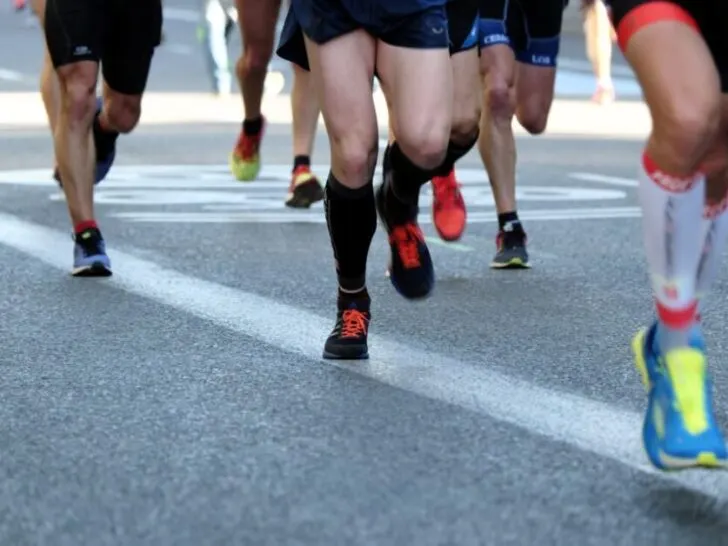Some of the links in this post are affiliate links. This means if you click on the link and purchase the item, we will receive an affiliate commission from the vendor at no extra cost to you. These business relationships allow us to keep bringing you great EatMoveHack content. All opinions remain our own.
Running is clearly one of the healthiest things you can do to support your body. But did you also know it can be an effective weight-loss strategy? Running and weight loss can go hand-in-hand if you approach it correctly.
Many people who have some weight to lose assume that running isn’t for them. They often worry unnecessarily about the bad reputation running has for hurting people’s knees, ankles, and other joints and how that risk is higher for heavier people.
While it is true that all runners are at risk of injury, in this post we’ll look at how to use running as a weight-loss tool while keeping yourself feeling good and avoiding injuries. I lost over 100 pounds following these tips, and I love sharing them with people. Running is an inclusive activity that most people can do, so let’s take a look at how running can be a great weight-loss program with a wide variety of health benefits.
Start Slow
 When you set out to use running as your primary way to lose weight, be sure to take it slowly. Remember, we are looking for long-term success on this weight-loss program, so don’t rush the results.
When you set out to use running as your primary way to lose weight, be sure to take it slowly. Remember, we are looking for long-term success on this weight-loss program, so don’t rush the results.
Just like with any exercise program, if you jump at it with 110% without any time getting used to the activity, you’ll quickly give up and slide back to where you were.
Running is a great form of exercise, and one of the most effective cardiovascular exercises that you can do. However, running needs to be approached with respect. There is a lot that can go wrong if you’re not paying attention to your pace and effort. You can start out slow by only running a mile or two at a very moderate pace. You can also consider an alternating walk/run schedule, where you walk for a few minutes and then run for one. These training strategies can help you acclimate yourself to running in a safe way.
A key to preventing overuse injuries is to make sure you rest and recover properly between each run. Always listen to your body and take your time. Listening to your body will greatly reduce your injury risk. Embrace your rest days and use a day of rest to get stronger and prepare yourself for the next phase of your running program.
You may start to hear runners talk about “running through” an injury. This is when they know something hurts, like a sore hamstring or sprained ankle, but choose to run through the pain in the hopes that they’ll push through it and heal faster. Do not do this! While it is true that for some types of muscle soreness, staying active on the muscle is a way to help it heal, there are just too many risks to running through an injury that make it a bad idea.
Watch Your Heart Rate
Your heart rate is the most important piece of data you can use to ensure you’re working towards your weight loss goals. Make sure you are working hard enough to bring your heart rate up to a level where you’re burning the most calories. For most people, this is in the 75-85% range, as a percentage of their maximum heart rate.
The longer you sustain a heart rate within that range, the more calories you’re burning!
Monitoring your heart rate is easy if you have a smartwatch. If not you can even do it the old-fashioned way with two fingers on your neck. Either way, you don’t have to get obsessive over making sure you’re always at a specific heart rate. You just want to be able to acknowledge when you’re taking it too easy, or too hard, and adjust accordingly.
Count Your Calories
 No one likes counting calories, but the reason the calorie information and calculation process exist is because the formula has not changed in decades. Weight loss happens when the calories you burn exceed the calories per day you have eaten.
No one likes counting calories, but the reason the calorie information and calculation process exist is because the formula has not changed in decades. Weight loss happens when the calories you burn exceed the calories per day you have eaten.
Running burns lots of calories. This will give you a leg up in the calculation to get yourself going towards your goal weight.
In addition, focus heavily on a healthy diet if you want to achieve your running and weight loss goals. Healthy foods and a balanced food intake program will ensure that you don’t consume extra calories which would lead to enhanced body weight. Fad diets will make it difficult to achieve your personal goals. Here are some articles from EMH that can assist you in your journey towards finding a diet that can assist you on your path.
Don’t Forget to Stretch
The number one way to prevent injuries is to stretch properly after a run. It is important to develop a stretching routine that matches your physical activity. It should be a routine that hits all of the major muscle groups – think hamstring, calves, glutes, and quads. If you have any specific aches or pains after a run, be sure to put some focus on those areas.
There are other tools and techniques you can use to help ease your muscles after a run, but none of them are good enough to completely replace stretching. These include foam rollers, stick rollers, handheld massage units, and many others.
Many runners say that their preparation for their next run starts the minute they finish their current run. This is a good way to think about it, and stretching is usually one of those first activities after a run that gets this preparation started.
Here are some of our favorite running stretches to help you along your path.
Forget the Elliptical
Sure, an hour on the elliptical machine may help you work up a good sweat, but I find it hard to get my heart rate up to anywhere near where it is when I’m running.
That feeling of exhaustion that comes after a good long run just isn’t available on an elliptical or any other kind of exercise machine. I always prefer going for a run outside to any of these other forms of cardio exercise.
Keep Making Progress
 You will see the pounds start to come off. The more you run, the more calories you burn, and the fitter and healthier you become. Set long-term goals for your running journey. You didn’t have weight gain in a few weeks and you are not going to see the weight all fall off in a few weeks either. Have a plan for running and weight loss and keep your eye on the ultimate goal of being the best version of yourself possible.
You will see the pounds start to come off. The more you run, the more calories you burn, and the fitter and healthier you become. Set long-term goals for your running journey. You didn’t have weight gain in a few weeks and you are not going to see the weight all fall off in a few weeks either. Have a plan for running and weight loss and keep your eye on the ultimate goal of being the best version of yourself possible.
Your body will get accustomed to your training schedule. This applies to any form of exercise. Eventually, you’ll hit a plateau in terms of the rate of weight loss. Your body will slow down the fat burning as it becomes accustomed to the demands of running.
When this happens… run longer! And faster, if you’re able to. High-intensity running can be a great tool to help you push through to the next level while increasing your metabolic rate.
Plateaus are normal, and everyone trying to lose weight has experienced one. The important thing is to not let a plateau upset you and make you feel like you should give up. A weight-loss plateau is a time to crank it up a notch, not turn it down!
Conclusion
I hope by now you’ve seen that running is not a sport just for the ultra-thin and ultra-fast. Running is an activity for everyone. It is a great tool that can be used to maintain a healthy lifestyle and find your healthy weight.
Also, maybe consider running a bit without headphones. Check out our article here for some of the benefits of leaving the headphones at home.
Sometimes, it is also great to set a long-term goal for yourself. Putting a race on your calendar can be a great way to keep you motivated. Here is our favorite site to find a race to fit your skill level – from a 5k to 240 miles, UltraSignup has them all. Happy Running!

